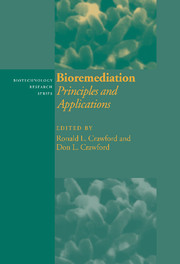Book contents
- Frontmatter
- Contents
- List of contributors
- Preface
- Introduction
- 1 Engineering of bioremediation processes: needs and limitations
- 2 Bioremediation in soil: influence of soil properties on organic contaminants and bacteria
- 3 Biodegradation of ‘BTEX’ hydrocarbons under anaerobic conditions
- 4 Bioremediation of petroleum contamination
- 5 Bioremediation of environments contaminated by polycyclic aromatic hydrocarbons
- 6 Bioremediation of nitroaromatic compounds
- 7 A history of PCB biodegradation
- 8 Bioremediation of chlorinated phenols
- 9 Biodegradation of chlorinated aliphatic compounds
- 10 Microbial remediation of metals
- 11 Molecular techniques in bioremediation
- Index
1 - Engineering of bioremediation processes: needs and limitations
Published online by Cambridge University Press: 28 October 2009
- Frontmatter
- Contents
- List of contributors
- Preface
- Introduction
- 1 Engineering of bioremediation processes: needs and limitations
- 2 Bioremediation in soil: influence of soil properties on organic contaminants and bacteria
- 3 Biodegradation of ‘BTEX’ hydrocarbons under anaerobic conditions
- 4 Bioremediation of petroleum contamination
- 5 Bioremediation of environments contaminated by polycyclic aromatic hydrocarbons
- 6 Bioremediation of nitroaromatic compounds
- 7 A history of PCB biodegradation
- 8 Bioremediation of chlorinated phenols
- 9 Biodegradation of chlorinated aliphatic compounds
- 10 Microbial remediation of metals
- 11 Molecular techniques in bioremediation
- Index
Summary
Introduction
The selection of microbiological processes for treating soils and groundwater contaminated with organic pollutants requires characterization of the waste, selection of an appropriate microorganism or consortium, and information about degradation pathway and rates. This chapter will focus on ex situ processes and the selection of reactors for the treatment of soils and groundwater.
Bioremediation must compete economically and functionally with alternate remediation technologies, which are often incineration and chemical treatments. Bioremediation usually competes well on a cost basis, especially with petroleum products and many solvents. A drawback, however, is the large amount of preliminary information necessary to support process design. When information on waste characteristics, microbial physiology, and the complex options for process design and operation is lacking, bioremediation can be more difficult to apply than alternate technologies. The variable end results of bioremediation are due in large part to these complexities of process design.
The engineering of bioremediation processes relies on information about the site and about candidate microorganisms. Process analysis usually begins with fixed waste characteristics but with options for microbial cultures, reactor types, waste pretreatment, and process operating conditions. Laboratory measurements are necessary to explore these options and to design an efficient process. Laboratory tests that examine degradation rates as functions of critical operating parameters such as pH, oxygen and nutrient concentrations, microbial composition, soil particle size, temperature, and redox potential shape the design of a bench-scale process. At a small scale mass transfer effects such as agitation and aeration are also explored. These tests form the basis for scale-up to the field scale and for the implementation of process control.
Many aspects of this design strategy have been presented.
- Type
- Chapter
- Information
- BioremediationPrinciples and Applications, pp. 13 - 34Publisher: Cambridge University PressPrint publication year: 1996
- 9
- Cited by



